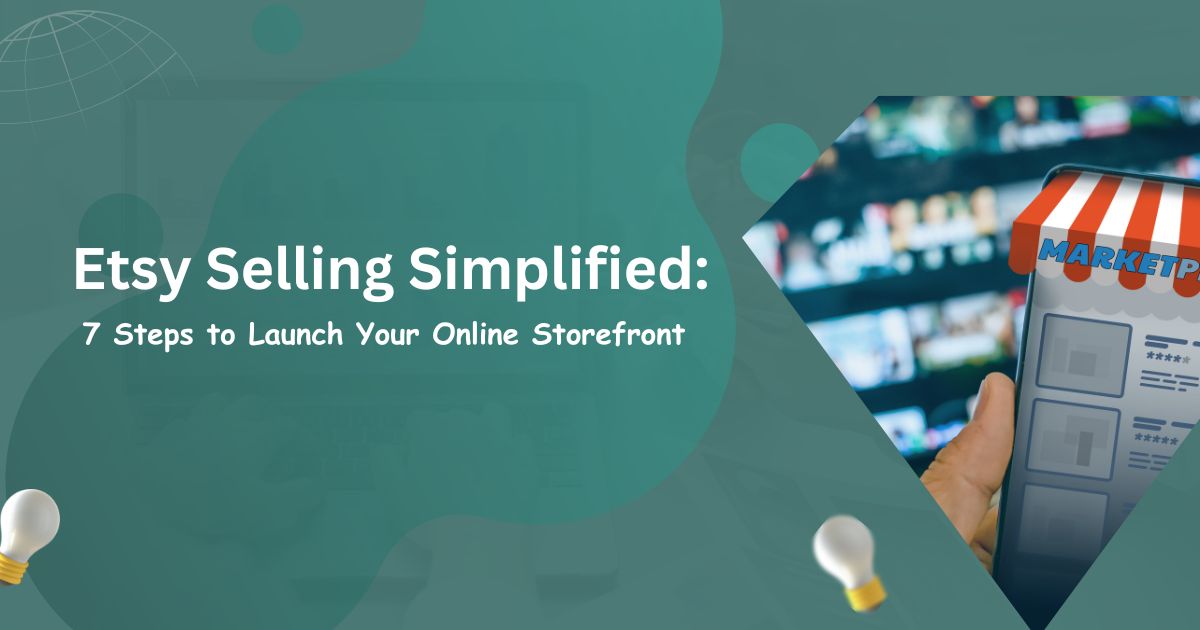Small businesses need multiple channels for selling their products. Choosing the right spaces to sell can take extensive market research and cost analysis.
Finding the right online spaces, for example, can mean determining whether to build and maintain your own website or using existing marketplace platforms such as Facebook, eBay or Etsy.
Etsy is a great way to sell products and leverage the built-in tools that the platform provides for small businesses. But Etsy can be intimidating if you are not familiar with using the platform and its features.
Here are 7 simple steps to take to start selling on Etsy.
1. Understand What Etsy Is, Including Fee Structures
Etsy is a U.S.-based e-commerce platform that focuses on selling handmade and vintage items. The products range from jewelry and clothing to home décor and furniture, along with art, toys, crafts and supplies.
Vintage items must be at least 20 years old. While it focuses on handmade items, Etsy began allowing sellers to sell mass-manufactured items in 2013.
Etsy is a massive online marketplace, with more than 100 million items for sale and 7.5 million sellers. More than 95 million buyers have made a purchase off the platform.
While there are no upfront costs for creating a storefront on Etsy, sellers pay various listing and transaction fees.
Listing fees are the most common, Sellers are charged 20 cents for every new listing that’s uploaded to their online store. This fee is charged whether the item sells or not. Listings remain active on the site by default for four months or until an item sells. You can auto-renew meaning the 20 cents is charged once the first four months are finished.
Transaction fees include a 6.5 percent fee to Etsy for facilitating the sale. Owners in the U.K., France, Italy, Spain and Turkey also pay regulatory operating fees on each listing of 0.25 percent to 1.1 percent.
You’ll also pay a payment processing fee, which is a percentage of the sales price and varies by country.
2. Create Your Business Structure
When you own your own business, you’ll need to choose a business structure, which is the legal business organizational type. There are many different business structures to choose from; however, most small businesses opt to either form a sole proprietorship or limited liability company (LLC).
Each business structure has its own benefits and drawbacks, especially related to taxation, liability protection and management.
Sole Proprietorship
This structure is the simplest and easiest to file, because there is no formal paperwork to complete. In a sole proprietorship, a single owner is responsible for all aspects of the business.
The company’s revenues, losses and expenses are passed through to the owner’s individual federal and state tax returns.
There are many benefits to being a sole proprietor. There are low start-up costs and you can be your own boss. You keep all the profits and can change the business structure easily in the future if you choose.
From a liability perspective, the sole proprietorship structure does carry some risks. If there is a court judgment against the company or a bankruptcy filing, your personal assets, such as your home, car and savings, are at risk.
LLC
An LLC is the most popular choice among small-business owners. With an LLC, the business is a separate legal entity. The owner or owners (called “members”) can choose to run the business themselves or hire a manager to run the company.
Taxes operate similarly to under the sole proprietorship model, passing through to owners’ individual tax returns. From a liability perspective, an LLC provides protection against court judgements, meaning their personal property is protected.
An LLC does require a formal filing within a state and, depending on the state, annual paperwork. The fees for filing an LLC can cost from a few hundred dollars to thousands of dollars.
3. Set Up Your Account and Add Products
To get started on Etsy, you’ll need to open a seller account by registering and entering in some personal details. You’ll then open a storefront after setting preferences for your language, country and currency.
If you already have a name for your business, you probably want to use it, if it’s available, for your Etsy store. If it’s not available, consider choosing a name that’s similar to your company name.
Shop names on Etsy can be 20 characters or fewer.
After you’ve created your store, you can start entering products. You can begin by uploading products to your Etsy store and add features, including:
● Photos. Each listing can have up to 10 photos. Etsy suggests adding photos that cover the different angles and views of your product to show it from multiple vantage points
● Listing Details. Good descriptions can make a listing sing. Be sure to list what the product is, what it is made of and who made it. Describe the materials that were used to make the item, whether it’s a physical or digital product and the dimensions. Using good keywords can help your products show up in search engine results
● Videos. Adding videos to your listings is optional. Like photos, they can help show the product from different angles. They can also show how a product works or its uses in different scenarios
● Product Variations. If you offer a product in different iterations, be sure to enter them. You can list the different sizes, colors and shapes for your products
● Personalization. Will you offer product personalization, adding names or other personal details to a final product. If so, be sure to add that feature to your listings by toggling that option on
4. Build Out Your Etsy Store
Building out your Etsy store is an important way to stand out. Your bio is one important area. Be sure to create a bio that’s compelling, explains what your store is all about and a little about yourself.
You should also spend some time customizing your storefront. Consider the fonts and colors you use and make sure your listings are well written.
5. Establish Customer Payment, Shipping and Remittance Processes
You may have several options when it comes to how you collect payment and ship your Etsy products. Pricing is the first element to consider, including factoring in the cost of the materials, labor and other business expenses. If you plan to offer free shipping, be sure to include those costs into your pricing.
You may also want to offer alternate pricing for domestic vs. global customers to account for the differences in shipping costs.
Payment details are another important consideration. You’ll need to enter a credit card to pay for listing and transaction fees.
Sellers have two options when it comes to shipping your sold items. You can set your shipping preferences on a per-product basis or so they apply to your full store.
If you will offer free shipping on smaller items that do not cost a lot to ship, but will charge for larger, heavier items, the first option probably makes the most sense financially. For larger items, using corrugated boxes ensures protection during transit, and the cost of these boxes should be factored into your shipping pricing.
6. Market Your Business
Etsy has some great search tools that allow your store and products to be found. But those tools alone will not be enough to draw customers. You’ll also want to invest in social media and paid ads to attract the customers most likely to purchase items from your shop.
Social media marketing lets you highlight your brand and your store. You can use social media to showcase certain products, advertise sales and let customers know about new products or variations. TikTok, Instagram and Facebook are popular social media platforms that Etsy shop owners have used successfully to cross-promote their products.
Etsy Ads are a feature that lets you advertise your products across the Etsy platform. Etsy Ads ensure your products show up in search results, category pages and market pages both on the Etsy website and app.
Etsy ads help your products stand out compared to similar products and give you more attention to your target audience.
7. Optimize Your Etsy Store
Want to get the most out of your Etsy shop? Understand that Etsy, like other selling platforms, uses algorithms to drive activity and sales.
The Etsy algorithm connects users’ search queries with the products on the platform to deliver search results. Here are some tips to maximize your efficacy with the Etsy algorithm:
● Use relevant keywords in product titles and descriptions
● Use relevant tags on your product listings
● Encourage and display reviews on your product pages
● Select the right attributes when writing listings
● Update your storefront with new content
● Make sure your About Me section is detailed
An Etsy store is a great way for your small business to sell your products. By understanding how Etsy works and spending the time to create your Etsy storefront, you’ll be well positioned to generate sales.
Be sure to use all the free features that Etsy provides and enhance your listings with great descriptions and photos. Also consider how you’ll market your Etsy store on the platform and other social media channels.




